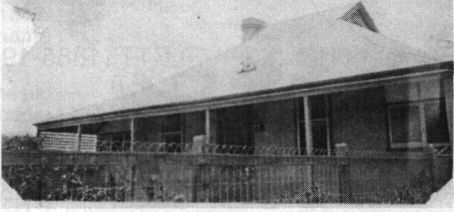

The Folk from the Wind Wound Isle > Chapter 17 : The Children of Margaret Robertson and George Chiselett
page 93
Note the different spellings, with Arthur using Chislett and William using Chiselett
Arthur John CHISLETT (1872-1951)

Arthur Chislett and Emma Staub, 1900
First child and eldest son of Margaret Robertson and George Chiselett, born at Tooliorook on 17 February 1872.
Arthur was shearing at Beulah with his father in 1894 when George Chiselett died there.
While working in the Wimmera, Arthur met Emma STRAUB (1879-1969) and the couple married in Melbourne in 1900.1 They lived on a dairy farm at Cobrico near Cobden, for the first years of their marriage. Gordon Croft says they moved to Lah in 1911, where Arthur bought a tractor and chaff cutter and worked as a contractor cutting chaff. In 1913 he bought an orchard near Warracknabeal.2 By this time, six children had been born into the family and four more were added by 1922. The children were George, Albert (who died soon after birth), Bertha, Grace,
Keith, Clarence, Gordon, Lindsay, Stanley and Norman.
Like his father and other members of his family, Arthur suffered from asthma.
This was apparently one of the reasons prompting the family’s move in 1916 or 1917 to northern Victoria where the climate was warmer and drier. Arthur had no trouble with asthma after the move. At Merbein on the Murray River, Arthur took up fruit growing for the dried fruit industry. His seven sons worked on the farm.
Arthur took an active interest in community organizations; schools, the Ratepayer’s Association and the Auxiliary for the Blind. He was secretary of the Merbein Church of Christ, and a Life Governor of the Base Hospital. Becoming involved in local government, he served on the Mildura Shire Council for twenty-two years and was President of the Shire for two terms.3
Norm Chislett describes his father as a rather distant figure of whom he has few happy memories. On one occasion when Norm was sick in bed for a month, Arthur hardly came in to see him. He reckons his father had it pretty good with all the family working for him. Norm and Claire (Gordon Chislett’s widow) speak of Emma with great affection - a caring person who carried the load of looking after the family. She had no mod cons and worked hard. The washing
page 94
was done with a ‘plunger’ and all the water had to be carted. She used to cut down clothes from one child to the next, and sold milk to make extra money.4
In 1943 Emma and Arthur sold their farm at Merbein and retired to Mildura. Arthur died there in 1951 at the age of seventy-nine. Emma died in Adelaide in 1969 at the age of ninety. They are both buried at Mildura.

Arthur Chislett’s Family Left to right, back row: Keith, Gordon, Stanley, George, Clarence, Lindey, Grace, Bertha. Seated: Norman, Arthur, Emma
The Folk from the Wind Wound Isle
was done with a ‘plunger’ and all the water had to be carted. She used to cut down clothes from one child to the next, and sold milk to make extra money.5
In 1943 Emma and Arthur sold their farm at Merbein and retired to Mildura. Arthur died there in 1951 at the age of seventy-nine. Emma died in Adelaide in 1969 at the age of ninety. They are both buried at Mildura.

Arthur Chisiett’s Family Left to right, back row: Keith, Gordon, Stanley, George, Clarence, Lindey, Grace, Bertha Seated: Norman, Arthur, Emma
page 95
Margaret Henderson Selina Georgina CHISELETT (1876-1939) - MARRIED NAME CROF
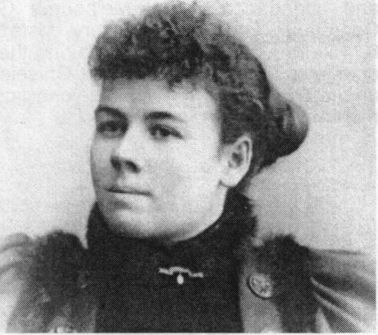
Selina Chiselett
Second child and eldest daughter of Margaret Robertson and George Chiselett, born at Ellerslie on 11 November 1876. Known as Selina.
Gordon Croft, in his books about the Chiselett and Croft families, says that after their father’s death in 1894, it was necessary for the Chiselett girls to make their own living.6 Selina’s first job was with a Dr Fleetwood in Warrnambool. She moved to Melbourne where she and her sister Susan obtained work as domestics. For some years Selina worked as a cook at the Queen Victoria Hospital in Melbourne.
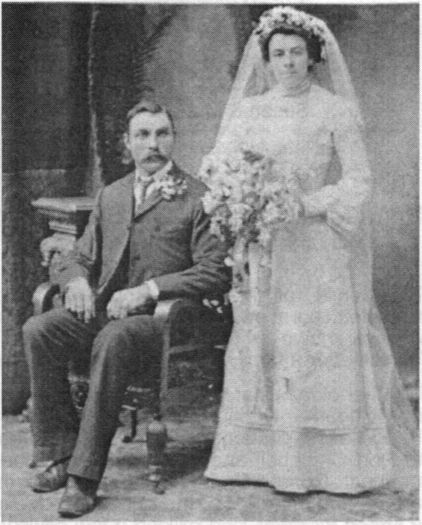
In 1904 Selina married Harry CROFT (1872-1949) at Port Campbell. Harry was the sixth child of Henry Croft and Ann Merrett. Both the Croft and Merrett families had come to Australia from Gloucestershire in England. Before moving to Port Campbell in 1884, the family lived on the western side of Peterborough, further along the coast towards Warrnambool, at Croft’s Bay.
Selina and Harry initially settled on a farm at Curdies Inlet but later moved into the Croft home at Newfield, inland from Port Campbell. This farm was called ‘Dursley’ after the town where Ann Merrett had been born. The property is now owned by Jeff and Di McCue. Jeff is descended from Margaret Robertson’s sister, Agnes.
Selina and Harry had one child, a daughter named Ruby (1905). In 1919 the family moved to land near Camperdown, but lived there for only two years before moving into Camperdown township and early retirement. Selina’s mother came to live with them shortly before her death in 1925.
Selina died in 1939 at the age of sixty-three. Harry lived for another ten years. They are both buried in the cemetery at Camperdown.
Harry Croft and Selina Chiselett On their wedding day in 1904.
Fourth child of Margaret Robertson and George Chiselett, born at Ellerslie on 2 January 1879.
After her father’s death in 1894 Susan found work in Melbourne as a domestic. While she was there a typhoid epidemic broke out and Susan was one of the victims of the disease. Her sister Selina was the only family member with Susan when she died on 27 February 1899, and it was Selina who arranged for Susan’s burial in the Baptist section of the Melbourne General Cemetery.
page 96
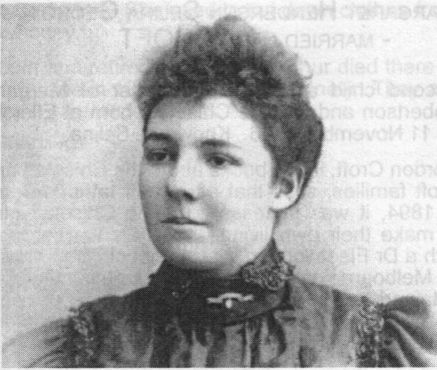
Susan Chiselett
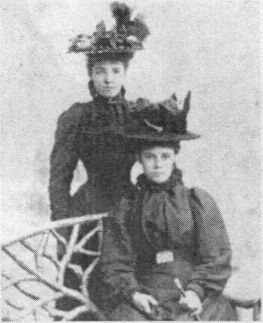
Susan & Muriel Chiselett
Gordon Croft gives details of a receipt for the burial as follows: “One Cloth-covered and Mounted Coffin, inside lined and upholstered; and including Hearse and pair of horses and attendance to the Melbourne General Cemetery. Cost £4. Cemetery costs £2-10-0.“ Gordon also tells us that during the same epidemic Susan’s Uncle John Chiselett was another victim, dying at Geelong just one month after Susan.7
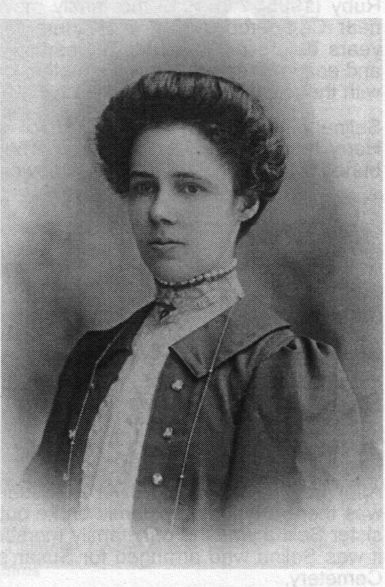
Muriel Chiselett
Edith Muriel Wilson CHISELETT (1882-1963) - MARRIED NAME DICKINSON
Fifth child of Margaret Robertson and George Chiselett, born at Port Campbell on 8 March 1882. Always known as Muriel. She was given the name Wilson after a family her mother was friendly with.
Like her older sisters, Muriel found work as a domestic in Melbourne, working for a Miss Puckles at Moonie Ponds as a parlour maid. In 1905 Muriel returned to Port Campbell and lived with her mother until she married. Gordon Croft tells us, “She took the place of a man and did most of the outside work, slaughtering a sheep for meat, and milking a few cows was all in a day’s work.”8
At the age of forty-one Muriel married James DICKINSON and they lived on a dairy farm at Newfield. They had no children. I have no other information about James except that he died before his wife. Muriel died at Timboon in 1963 and is buried at Port Campbell.
page 97
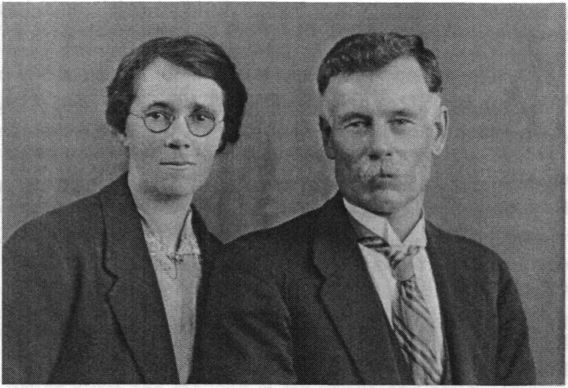
Murial and James Dickinson
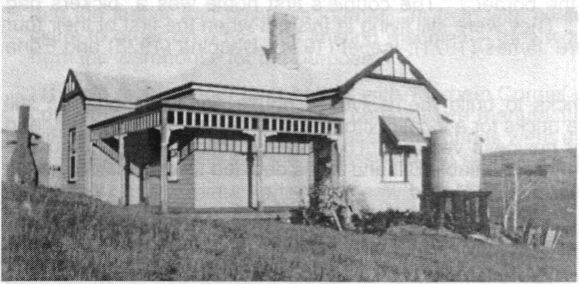
Dickinson homestead, Port Campbell
Elizabeth Ruth CHISELETT (1885-1940) - MARRIED NAME CROFT
Eighth child of Margaret Robertson and George Chiselett born at Port Campbell on 22 November 1885. Known as Ruth.
Ruth sometimes substituted for Muriel in her work for Miss Puckles and she also worked as a domestic at the Eye and Ear Hospital in Melbourne. In 1905 she married Richard CROFT (1878-1947) who was the younger brother of Selina’s husband. It is interesting to note here that Dick and Harry’s older brother, George Croft, married Margaret Mathieson who belonged to the same Mathieson family some other Robertson descendants married into (see Appendix 3). I believe George and Margaret’s son, Aenger Croft, has written a history of the Mathieson family, but I have not been able to get a copy this.
Ruth and Dick had a farm called ‘Widdicombs’, across the road from his parents’ farm, and the first two of their three children were born there, Muriel (1906) and William (1909). Their third child, Gordon, was born at Pinnaroo. Ruth was another member of the family who suffered from asthma and she and Dick moved to Murrayville in the Mallee for the sake of her health. There they established from scratch, a wheat and mixed farm, living in a tent beside a bore before their house was built. The family remained at Murrayville until 1937, when they moved to Nirranda on the south coast.
Norm Chislett remembers his Auntie Ruth using some sort of inhalation pipe to ease her asthma. He also tells us that a seemingly minor incident when Ruth was pierced with a sewing needle, resulted in a severe infection and Ruth’s arm had to be amputated.8 In 1940 Ruth died following
8 Interview with Norm Chislett, April 2000
page 98
a bout of asthma and was buried in the Warrnambool cemetery. Her husband joined her there seven years later.
William Adie Robertson CHISELETT (1888-1948) and Robert John CHISELETT (1888-1909)
William and Robert were the youngest children and the second set of twins born to Margaret Robertson and George Chiselett. They were born at Port Campbell on 18 June 1888.
The boys continued living with their mother during their teenage years, finding work around the district. Robert was killed in a quarry accident in 1909, shortly before his twenty first birthday (see Chapter 10).
In 1911 William went to live with his sister Ruth and her husband at Murrayville. There he helped them to clear scrub and establish their farm. In 1919 he moved on to Merbein to go into partnership with his brother Arthur on a ‘dried fruit’ block.
In 1920 William married Doris TYLOR (1895-1991). Doris grew up in Adelaide and came to Merbein to pick grapes on a cousin’s property. She could not return to Adelaide “because an outbreak of pneumonic flue closed the border”9. The couple’s first home was a “pickers bag hut on a property near the township”. They were still living in this hut when the first of their four children was born. The children were James (1921), Isabel (1924), Despina (1928) and Edna (1930).
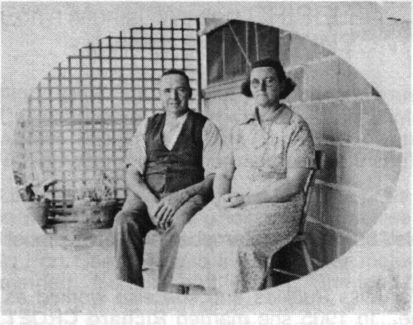
William and Doris Chiselett

Chiselett’s home in Merbein
William and Doris made cement bricks to build themselves a house and this house is still standing in Merbein. They also made bricks for a local doctor to build his home and surgery and earned money this way to start their business venture. The summer following their marriage was extremely hot and with no cool drinks available Bill and Doris decided to establish a cordial factory. The cordial factory was opened in 1921 and was run by the family until it was sold in 1970.
Isabel and Erik Nordin give us a vivid description of the cordial factory:10
“Doris’ father came up from Adelaide to help start it. He brought the recipes for syrup making and soft drink manufacturing with him and began in partnership with Doris and William.
“The first efforts were fairly crude. The bottles were from the bottle collectors and were washed in a large trough with hand held bottle brushes. The water was heated in a large copper and bucketed into the trough. The clean bottles were then rinsed with water jets whilst they were upside down on a system of pipes, then allowed to drain on a board with holes to hold them upside down. When drained they were place in boxes to be filled.
page 99
“Later on they arranged a system of a revolving brush that made work easier. Despina was at the trough one time and her hair was caught in the brush and was pulled into a tangle around it. Luckily someone turned the motor off before too much damage was done to her hair but one side of her head had to be cut free and she lost half her hair.
“The syrup was made of sugar and water in a 30 gallon glass lined vat. When dissolved it was filtered into buckets and the flavouring essence and citric acid were added for each specific flavour. Fruit juices were added to the fruit flavoured syrups.
“The syrups were poured into a copper container which had 4 cups (each holding 4 oz) on a centre spindle with pipes attached to the cups. The empty bottles were placed on these pipes and the weight of the bottle raise the cups and 4 oz of syrup ran into the bottle. They were then covered and taken to the filling section.
“William would fill each bottle with soda water on a machine one at a time working it with one foot on a pedal. The soda water was made in a carbonator which mixed CO gas and water to the required pressure for different flavours - 601b for plain drinks, 50Id for fruit drinks, 1001b for soda water. This soda water of 1001b was used to fill soda syphons.
“Under the pressure many bottles would burst and resulted in cut hands and arms. This method of manufacture was a slow process and meant many hours of toil during the hot weather. At night after working all day Doris would do the bookwork, keeping accounts and the ledger and business journal. To help with finances she also made jumpers and skirts to order on a two bed knitting machine - they would buy Paton’s 2ply wool in bulk from the warehouse for the purpose.

Cordial Factory, Merbein 1921
“The old stone ginger beer bottles with ‘Merbein Cordial Works’ logo are rare and valuable collectors items. The first stone bottles were manufactured in Scotland and were sealed with cork and tied with string. The soda syphons were also made in England and came in colours of blue, pink and clear glass with the name logo also on them.”
As the children grew older they worked in the factory labelling drinks and packing crates, and at the age of fourteen Isabel left school and took over the task of running the family’s domestic arrangements.
William was known as 'generous Bill’ because he gave free drinks to organizations that were fund raising. He suffered all his life from chronic asthma and smoked a herbal tobacco, called Tatulla, to clear his chest. Gradually the disease debilitated him and he died just short of his sixtieth birthday. He is buried in the Merbein cemetery.
The family continued running the cordial factory but after it was sold in 1970, Doris moved to Geelong where she lived with daughter Isabel and her husband. She spent the last nine years of her life into a nursing home and died there in 1961 at the age of ninety-five.
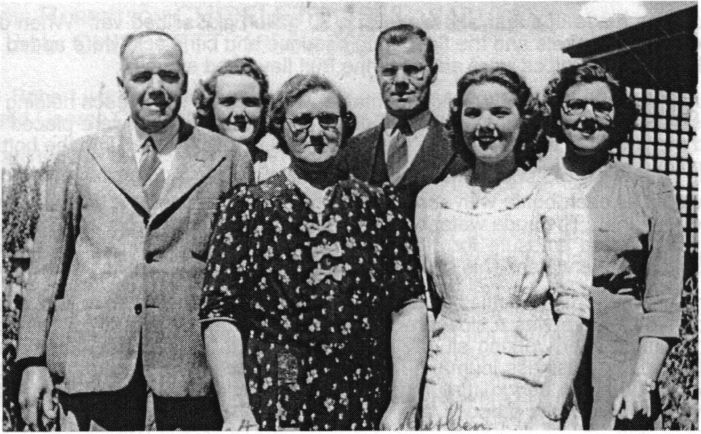
William Chiselett’s Family
Left to right: William, Despina, Doris, James, Edna, Isabel
1 Straub is sometimes spelt with an 'e’ (Straube) in the Victorian records
2 G. Croft, The Chiselett Story'
3 Obituary, from an unknown newspaper
4 Interview with Norman Chislett and Claire Chislett, April 2000
5 Interview with Norman Chislett and Claire Chislett, April 2000
6 G. Croft, ‘The Chiselett Story’ and ‘Croft Family History 1803-1974’. For details about Margaret Robertson’s children I have relied heavily on the information gathered by Gordon and presented in these books.
7 G. Croft, ‘The Chiselett Story’, p.54
9 Letter from Erik and Isabel Nordin, 8.3.2001
10 Information about this section of the Chiselett family was supplied by Isabel and Erik Nordin. The piece about the cordial factory is taken from the letter, 8.3.2001